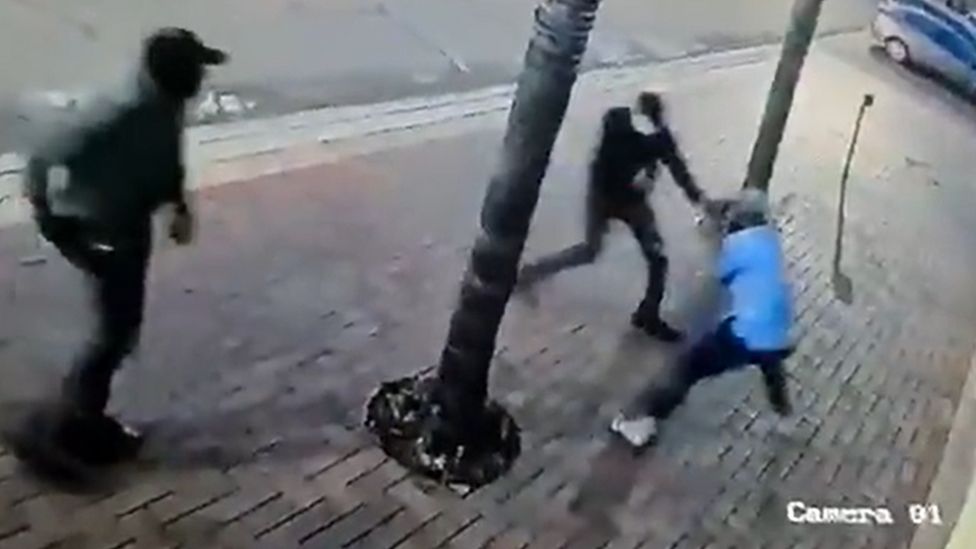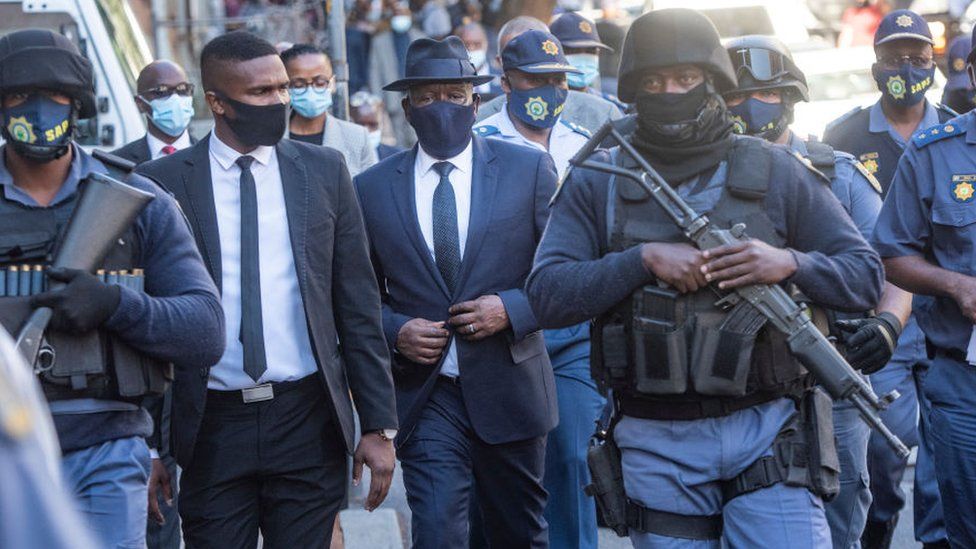Features
‘I survived a kidnapping but part of me died that day’

After a surge in the number of abductions in recent years, South Africa has one of the highest rates of kidnapping in the world, as Mpho Lakaje reports from Johannesburg.
Lesego Tau did not panic at first when a stranger opened the back door of her grey Mercedes C-Class and climbed in.
She had parked outside a shopping mall in Johannesburg and was focused on texting a friend before going in to grab a few items for a get-together that evening.
“In my rear view mirror, I was looking and still thinking: ‘This person is going to be so embarrassed when they realise they are in the wrong car’,” she told the BBC, recounting the events of last June.
But this was not an innocent mistake.
“Our gazes locked and I realised what was happening.”
This was a kidnapping.
Six months earlier, businessman Yasin Bhiku was grabbed in the driveway of his home, near Johannesburg, just after returning from the mosque.
CCTV footage that was widely seen on social media shows Mr Bhiku dressed in a blue T-shirt and black trousers calmly chatting to a friend.
Two men can be seen getting out of the car parked opposite. At first they stroll towards him, but then rush at him after Mr Bhiku realises what is going on and tries to flee.

He was overpowered and forced into the vehicle at gunpoint. The businessman was later found unharmed and rescued by the police.
Ms Tau, who runs her own cleaning company in Pretoria, also tried to flee once she had figured out that she was about to be abducted.
She said she tried opening the door of her car, but another man, dressed as a parking attendant in a hi-vis jacket, blocked the door.
The man in the back seat showed that he had a gun and ordered Ms Tau to drive out of the shopping complex.
Along the way, she was told to stop and someone else jumped into her car.
Four-hour ordeal
Once in the countryside, about 15km (nine miles) into the terrifying journey, the kidnappers ordered Ms Tau to stop.
A red car then arrived at the scene and someone got out, took her bank cards and forced her to reveal her security codes.
“The other people from the car… started going through all my different cards. They were withdrawing [money].”
At the same time, her captors were repeatedly hitting her on the head with the gun, ordering her to increase her withdrawal limit.
The ordeal went on for over four hours.
At one point she heard someone on the other end of a phone call say: “Just finish her off. We are done.”
“I made peace that they were going to kill me, but I thought, I need to fight. I have to fight. If they are going to kill me, I might as well fight,” Ms Tau said.
She fought her way out of the car, but the kidnappers grabbed her and started hitting and scratching her. She got away and ran across the road into the oncoming traffic.
This story and that of Mr Bhiku are not isolated.
In February, Police Minister Bheki Cele revealed that 2,605 kidnapping cases had been reported to the authorities in the last three months of 2021.
In the decade from 2010, kidnapping more than doubled in South Africa and there are now 10 kidnappings per 100,000 people, according to the South African think-tank the Institute for Security Studies. This is one of the highest rates in the world.
In 2018, Mr Cele promised to make dealing with kidnapping a priority.
Victims have been kept against their will either for a ransom, to have their bank accounts cleaned out or be sexually assaulted.
Some did not make it out alive, though it is not clear how frequent this outcome is.
In an attempt to deal with these kind of crimes, the police launched a kidnapping task team, combining intelligence gathering with tactical response.
Crime syndicates target South Africa
One thing that has been established is that kidnappers tend to work in teams and the abductions follow a pattern with each gang member having a set role, police spokesperson Col Athlenda Mathe told the BBC.
“The spotters are those that would follow the target. The pickers are those who move in to kidnap the victim.”
The kidnappers often drive high-performance vehicles and are usually heavily armed.
“Then we have the guards that would take over and keep the victim… until a ransom is paid.”
But in the background, there is a mastermind who does thorough research and pulls the strings.
“The kingpin would be someone who lives a high-end life and wouldn’t do the dirty job,” Col Mathe says.

These criminal syndicates have tentacles in countries like neighbouring Mozambique and as far afield as Pakistan.
They tend to mostly target wealthy business people with the means to pay a ransom, but some victims have been from low-income areas and children are not spared.
Private hostage negotiator Gérard Labuschagne says there has been an increase in very high-value cases. Ransoms can be set at up to $3m (£2.3m)
“Organised groups operating in Mozambique and other parts of Africa have now decided, for whatever reason, that South Africa is ripe for this type of crime and they’ve been committing it very successfully,” Mr Labuschagne says.
Some social commentators believe general lawlessness has made South Africa attractive to organised criminals from around the world.
In the face of public anger, the police acknowledge that more work needs to be done but Col Mathe says they have made progress.
“Since the identification of these syndicates, we have arrested 115 suspects, consisting of Pakistanis, Mozambicans as well as South Africans.”
One of the suspects is 43-year-old Faizel Charloos, who was taken into custody in March.
He is believed to be the mastermind behind a spate of recent kidnappings.
During police raids in several Johannesburg properties linked to him, drugs, cash and a high-powered vehicle were recovered.
Mr Charloos recently appeared in court, along with several others, on kidnapping charges. He has made no comment.
It emerged that he has dual citizenship in South Africa and Mozambique.
‘Police don’t rescue victims’
In a separate case in April, police successfully rescued a four-year-old girl who was snatched at a school in Johannesburg, by a woman pretending to be her childminder.
Her kidnappers had earlier demanded thousands of dollars for her safe return.
But four people were arrested when they arrived outside a shopping centre to collect the ransom.
Despite such breakthroughs, Mr Labuschagne is not convinced the police are winning.
“We have had one or two arrests. But in the overwhelming majority of these cases, the police don’t rescue the kidnapped victims from where they’ve been kept. They are released after a payment.”
Ms Tau was lucky that she managed to get away, but her kidnappers took $1,400 (£1,100).
The ordeal has damaged her psychologically and left her family distressed.
“My father is not a man who cries, but he got teary. He kept on feeling like he could have protected me.
“There’s still a part of me that actually died on that day.”
Source: bbc
Features
Who knows tomorrow?
Recently a friend posted a sad news on his Facebook page, announcing the death of a school mate who had passed away, suddenly. The report had it that he was on his way to the airport to take a flight to Ghana.
I am sure this man had already informed the wife or a friend or a work colleague at work that he was returning home but he was not to return as a human being but as a dead body.
Such is life and so we need to be circumspect in how we go about things in life. The Bible reminds us that we are like grass which at one point in time looks elegant and the next moment becomes withered according to Psalm 90:5 and 6. It is for this reason that we need to guard our hearts with the word of God so that we shall be motivated to do the right thing, at all times.
This will enable us live on this planet, free from all sorts of troubles in our personal lives, even if we ignore the question of Heaven and Hell. Living a disciplined life delivers us from any kind of trouble as the Bible declares in Galatians 5:23 that against such there is no law.
The uncertainty surrounding our lives on earth is the more reason why people should commit their lives into the hands of the one who created it, in the first place unless you believe that the world created itself and that it appeared from nowhere.
Otherwise, the logical thing to do is to recognize the authority of the creator and surrender to his Lordship. Heaven is real and Hell is real, so for us who know the truth and have received Jesus as our Lord and Saviour, the onus lies on us to encourage our relations who have not believed and received Jesus into their lives, to do so.
We are a couple of days from another Easter Resurrection celebration and an opportunity to reflect on our lives in relation to the significance of Easter. In the Bible, the only occasion Jesus, Saviour of the world commands us to celebrate is his death and resurrection.
He never commanded his followers to celebrate his birth but like everything else, we chose to ignore Jesus’s instructions and decided to do what pleases us, just like our forefather and mother in the Garden of Eden.
Let us deliberately choose to do things differently as Christians this Easter, so we can really benefit from all the blessings that the celebration of the death and birth of Jesus, has on offer. Doing the same thing over and over and expecting a different result is definitely insanity.
I choose to be different this Easter and I am believing God for a newness of life so God’s glory would be revealed in me to draw the unsaved to him. It is only when people especially the unsaved, see the character of Christ in us, that they can be convinced about the authenticity of Jesus, as Saviour of the world, who can bring transformation in their lives too.
This is what would motivate them to surrender their lives to Jesus Christ. Let us make this Easter a memorable one that will be cherished for a long time. It is also a period for reconciliation and it would be great if in the spirit of Easter, we would try to reach out to those who have wronged us or have a grudge against us.
This would demonstrate that we have indeed accepted Jesus and that our religious posture is not a sham. May the good Lord grant us the grace to love our neighbours as ourselves, demonstrating the love of God in the process.
Those who have lost their loved ones and Easter brings sad memories, may the good Lord comfort and strengthen you. God bless.
.NB: ‘CHANGE KOTOKA INTERNATIONAL AIRPORT TO KOFI BAAKO INTERNATIONAL AIRPORT’
Features
Cosmetic deformities
COSMETIC deformities refer to physical imperfections or abnormalities that affect an individual’s appearance, often causing emotional distress and impacting their quality of life.
These deformities can be congenital, acquired, or result from various medical conditions or treatments. This article provides an in-depth exploration of cosmetic deformities, their types, causes, effects, and treatment options.
Types of cosmetic deformities
Cosmetic deformities can affect various parts of the body, including the face, skin, hair, nails, and teeth. Some common types of cosmetic deformities include:
1. Facial deformities: Congenital or acquired abnormalities affecting the shape, structure, or appearance of the face, such as cleft lip and palate, facial paralysis, or facial asymmetry.
2. Skin deformities: Conditions affecting the skin’s texture, tone, or appearance, such as acne, scars, birthmarks, or skin discoloration.
3. Hair deformities: Abnormalities affecting the hair’s growth, texture, or appearance, such as alopecia, hirsutism, or hair loss due to medical conditions or treatments.
4. Nail deformities: Conditions affecting the shape, size, or appearance of the nails, such as nail fungus, nail psoriasis, or nail trauma.
5. Dental deformities: Abnormalities affecting the shape, size, or appearance of the teeth, such as tooth decay, tooth loss, or malocclusion.
Causes of cosmetic deformities
Cosmetic deformities can result from various factors, including:
1. Genetics: Congenital conditions or inherited traits can cause cosmetic deformities.
2. Trauma: Injuries or accidents can result in cosmetic deformities, such as scars or facial trauma.
3. Medical conditions: Certain medical conditions, such as acne, psoriasis, or eczema, can cause cosmetic deformities.
4. Treatments and procedures: Medical treatments, such as chemotherapy, radiation therapy, or surgery, can result in cosmetic deformities.
5. Aging and environmental factors: Aging, sun exposure, and environmental factors can contribute to cosmetic deformities, such as wrinkles, fine lines, or age spots.
Effects of cosmetic deformities
Cosmetic deformities can have significant emotional and psychological effects on individuals, including:
1. Low self-esteem: Cosmetic deformities can lead to feelings of insecurity, self-consciousness, and low self-esteem.
2. Social anxiety: Individuals with cosmetic deformities may experience social anxiety, avoiding social interactions or feeling embarrassed in public.
3. Emotional distress: Cosmetic deformities can cause emotional distress, including depression, anxiety, or stress.
4. Impact on quality of life: Cosmetic deformities can affect an individual’s quality of life, impacting their relationships, career, or overall well-being.
Treatment options for cosmetic deformities
Various treatment options are available to address cosmetic deformities, including:
1. Surgical procedures: Surgical procedures, such as reconstructive surgery, cosmetic surgery, or dermatological surgery, can correct or improve cosmetic deformities.
2. Non-surgical treatments: Non-surgical treatments, such as laser therapy, chemical peels, or microdermabrasion, can address cosmetic concerns, such as skin texture, tone, or appearance.
3. Medical treatments: Medical treatments, such as topical creams, oral medications, or injectable treatments, can address cosmetic concerns, such as acne, hair loss, or nail deformities.
4. Prosthetic and orthotic devices: Prosthetic and orthotic devices, such as wigs, hairpieces, or dental prosthetics, can help individuals with cosmetic deformities.
5. Counselling and therapy: Counselling and therapy, such as cognitive-behavioral therapy or psychotherapy, can help individuals cope with the emotional and psychological effects of cosmetic deformities.
Conclusion
Cosmetic deformities can have significant emotional and psychological effects on individuals, impacting their quality of life and overall well-being.
Understanding the types, causes, and effects of cosmetic deformities is crucial in addressing these concerns.
Various treatment options are available, ranging from surgical procedures to non-surgical treatments, medical treatments, prosthetic and orthotic devices, and counselling and therapy.
By seeking professional help and support, individuals with cosmetic deformities can improve their appearance, boost their self-esteem, and enhance their overall quality of life.
Reference
1. “Cosmetic Deformities” by the American Society of Plastic Surgeons







